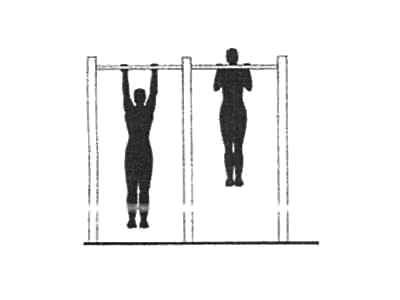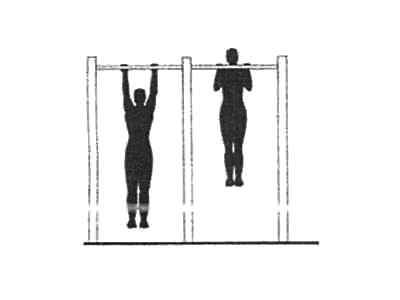How To Do Pull-Ups
by Melinda Misener


1. Want to.
I considered the pull-up — the proper pull-up, all the way down and all the way up, no lower-body jerking — to be graceful and complete in a way that lunges and push-ups and lifting barbells never could be.
2. Have a meaningful deadline.
I’d read that on January 1, 2014, all female Marines would be required to perform three pull-ups as part of an annual fitness exam. In late August, 2013, I decided to make the Marines’ deadline and minimum requirement my own.
3. Ignore less admirable motives.
Like envy: my otherwise capable body could not do pull-ups, and other bodies could. Also vanity — my arms! And, as always, the desire to appease my damnable perfectionism, which has always defined me as anywhere from marginally to majorly less than good enough.
4. Research training plans.
I Googled “how to do pull-ups.” Of course I saw the irony in my query: the mystery of pull-ups was not in how to do them but in how to get my body to do them. Online I found the Armstrong Pull-Up Program. Designed by a Marine with the surname (no irony, here) Armstrong, the Program called for five training days per week: push-ups in the morning and pull-ups in the afternoon. But the afternoon pull-up workouts called for “five maximum sets” or “nine training sets” or a “pyramid.” This Plan was for people who could already do pull-ups!
I liked the push-up idea, though, so I decided to borrow that. I also decided to use the pull-up machine at the gym, and do a bunch of pull-ups most days, and decrease the amount of assistance over time.
5. Implement your training plan.
The next morning, before I’d even peed, I planted my hands on the cool tiles of my kitchen floor for push-ups. Within thirty seconds I was bargaining with myself: what is a “max set” of push-ups? Is it enough if my whole body is quaking with effort? Or is “max set” defined by not being able to do another push-up if my life depended on it? The thought that I could reach a place of exertion where my choice was to either give up or die made me nauseous.
6. Start a log.
On yellow legal paper I wrote down the number of push-ups I did each morning, plus the number of sets, repetitions per set, and amount of assistance I got at the gym in the afternoons.
7. Cope with exhaustion.
I found myself resentful of people who expected things like handshakes. In meetings I sat very still, my hands on my lap, my arms so so heavy.
8. Conduct interviews.
So that whatever I wrote about my pull-up journey would be framed within a carefully researched context, I interviewed a local USMC Captain. I was planning on challenging him on what I was sure was rampant sexism in the Marines, but I ended up taking sheepish notes as he delivered party lines (Q: “Are female Marines given the same respect as males?” A: “All Marines are given Marine respect”) — partly because I am not very good at calling people out, and party because I noticed the brief embarrassed flutter of a smile cross his face each time he evaded my question. We were about the same age. I liked him, despite myself. I decided he was not part of the rampant sexism in the Marines, and when he offered to put me in touch with a female member of the local ROTC, I was appreciative. And when he said, at the end of the interview, “The Marine Corps is a meritocracy, plain and simple. You either perform or you don’t, and that’s the end of the story,” I believed him — or, I wanted to.
The Marine-option ROTC he put me in touch with was a senior at a local university. Her name was Olivia. She’d just finished a physical training session (grappling, incidentally). When I asked what she thought of the new standard, she said, “I was like, finally. I mean, I can do eight pull-ups in — ”
I interrupted: “You can do eight pull-ups?”
She shrugged. “Well, that’s the thing,” she said. She asked if I’d heard of the Armstrong Program. She also said, “To do pull-ups, you have to do pull-ups.”
I nodded sagely, as though I understood.
9. Fail.
Occasionally I tried to do unassisted pull-ups. Halfway up, I’d get stuck. The feeling wasn’t as painful as it was puzzling. Up, I told myself. Go up.
In time I saw that this stuckness, rather than any physical pain, was what made me so reluctant to try. I wondered how many times I’d overlooked powerlessness as the source of my discomfort. I philosophized: was it wiser, in general, to make peace with impotence or resist it by any means possible?
10. Consult an expert.
When a kinesiologist found out I was using a pull-up machine to do most of my workouts, he shook his head. “No, no, no,” he said. “The pull-up machine doesn’t teach you to move your whole body in space.” Whatever movements we do well, we’ve learned to do. How is running a sub-five minute mile different from playing a difficult piece on a trumpet? It’s all about what you teach your body to do, he said — or, what you allow your body to learn.
By the time I left his office I’d decided to title my essay “A Pull-Up is a Work of Art.”
I’d also decided to stop using the trainer.
11. Do one pull-up.
This was in mid-October. Halfway up, I got stuck, but briefly. I sensed the slack in this stuckness, and I pulled through it. I paused with my chin over the bar. I lowered slowly. I felt that this pull-up was not earned but given. I trembled. It was not quite my body trembling but my mind — it was as though I’d just solved a puzzle, as though I finally came up with the word that had been so long on the tip of my tongue.
12. Add more pull-ups.
After my first pull-up, I did at least five or six max sets on most days of the week. I was okay with the fact that a single “max set” of pull-ups meant one and a half. I trusted that that half would yield, eventually, and become two. And it did.
Also, I’d come to like doing push-ups in the morning — or at least, I came to appreciate the way morning push-ups shoveled my sleepiness aside, leaving me a clear path to the start of my day.
About every three weeks, I added another pull-up to my maximum: I got up to three, then four, then five.
I didn’t worry about the fact that my new personal bests had started feeling more like a personal stockpile and less like a cause for celebration.
13. Lose your meaningful deadline.
On December 27, 2013, a friend emailed me a link to a news article: the Marines’ new pull-up standard had been pushed back indefinitely because more than half the female recruits tested couldn’t do three pull-ups.
I opened a blank document on my computer. I typed, “Women can do pull-ups.”
I sat there for five minutes. I didn’t want to use myself as a model for female Marines, let alone “women,” at large. Sure, I saw pull-ups as a difficult but attainable exercise for the healthy and able-bodied. But it seemed unfair of me to comment on the fact that those women had missed the standard — what did I know of their lives, their training? Did I want to say that they hadn’t worked hard enough? Did I think that the Marines don’t know how to train women to do pull-ups?
I clicked “don’t save” on my way out.
14. Reframe the meaning of the pull-up.
I decided that my essay was less about pull-ups per se and more a meditation on how we see the challenges before us, in life, and what we do to prepare ourselves to meet those challenges. I met Olivia for coffee, to ask her more questions. She wore a wool coat that had a gold elephant pin on the lapel. I said I almost didn’t recognize her in “regular” (i.e., non-athletic) clothes. When she laughed, I noticed that she had a dimple, high on one cheek.
She asked how the pull-ups were coming. I said I’d hit six a couple times, and she congratulated me. We talked about how the new standard got pushed back. She said the story about women and strength needs to change, and I agreed.
I asked what she was most afraid of, and copied her words: My greatest fear is that I wouldn’t take an opportunity because I was afraid.
I finished my drink, closed my notebook. We talked about plans for the upcoming summer. I got the feeling we were sort of friends. We hugged before parting ways.
15. Revisit your notes.
Scribbled in a margin, I found: Surprisingly, I Like the Marines (potential title?)
I also found: The question is, what do you want to do with your body? Except most of us either don’t answer that question or don’t even acknowledge it’s there.
16. Think big!
So: I’d been using pull-ups as a way to deal with the fear of not knowing my own fate — the challenges life would bring me, how I would respond.
Or, no: my whole life was a means of dealing with the single long existential crisis that was my whole life!
17. Think smaller.
Maybe I did pull-ups because, somewhere deep down, I still liked the simple grace of it, that fluid up-up-up?
18. Win bets you never made.
I hoped to overhear some half-drunk guys at a bar talking about how women can’t do pull-ups. I’d challenge them to a bet. I’d do my pull-ups. Ta-da!
Problem is, not half as many men as I’d like sit around in bars, talking about how physically weak women are. Also, I don’t go to bars much.
My pull-up maximum is currently stalled at six, maybe because I don’t think six pull-ups will feel so different from ten: I’ll do some easily, and then some less easily, and then one that’s really hard, and then one last one that’s so fucking hard it requires me to sort of shut down my brain while I let my body figure out for itself how much it’s capable of.
There is value in this exploration of limits. And yet I am not convinced of the value of ten, or fifteen, or twenty pull-ups over six. When I think about my singular but currently undefined goal (after getting past three, I simply wanted to do more — but how many is enough?), I get tired. Not physically, but spiritually. I want to want something else.
19. Make a call.
“Hello?” says Olivia.
“Do you want to go rock climbing?” I ask.
Melinda Misener is from Maine.
Previously: “Interview with Zoë Romano, the First Person to Ever Run the Tour de France”